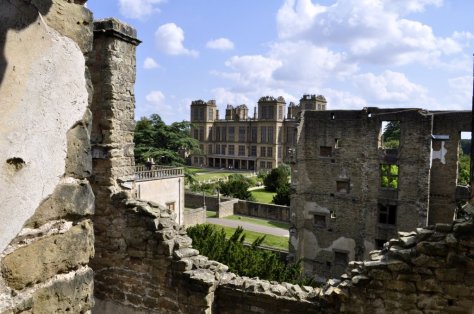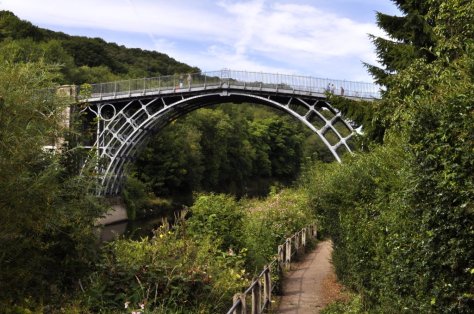It’s unusual to find properties managed or owned by English Heritage and the National Trust side-by-side. But that’s precisely the situation at Hardwick Old Hall and Hardwick ‘New’ Hall in Derbyshire.
With the weather set fair last Wednesday, we made the 177 mile round trip from our north Worcestershire home to visit ‘Hardwick Hall’, which we regularly pass on the M1 motorway when traveling to visit our younger daughter and her family in Newcastle upon Tyne. I had visited Hardwick once before, at least 50 years ago when my father organized an outing for the Leek Camera Club.
Standing on a ridge looking west over the Derbyshire countryside, Hardwick Hall was the later home of one of the most influential persons in Tudor times. Friend and confidante of Queen Elizabeth, Bess, Countess of Shrewsbury was originally from quite lowly stock, but through four and prestigious marriages (at least two of them in any case), she gained status and accumulated incredible wealth.

Hardwick Hall proclaims the status of the owner to all and sundry. Not for nothing is her monogram ‘ES’ displayed proudly on at least three sides of each of the six ‘towers’ of the hall.
The descendants of her second marriage, to Sir William Cavendish (d. 1557) are the Dukes of Devonshire, and Bess spent much of her married life to twice-widowed Sir William, at Chatsworth, still the ancestral seat of the Devonshires since 1549. She had eight children, two of whom died in infancy.
In 1568, Bess married George Talbot, 6th Earl of Shrewsbury (d. 1590), her fourth marriage, and one that brought her close to the royal court. For a number of years The Earl and Countess were given custody of Mary, Queen of Scots until she was removed from their care (essentially house arrest) and ultimately executed.
Hardwick Old Hall is now essentially a shell. After Bess moved to the ‘new hall’, and for centuries after, the house fell into disrepair, and during the 18th centuries, the building was reduced on purpose by the Dukes of Devonshire. One whole quarter of the hall, which housed the great hall I believe has disappeared altogether. But there is still a great deal to see, and English Heritage have made the greatest efforts to allow visitors to see the ruin in its entirety. The original stone staircase leads up to the top floor where there is now a wooden platform that enables everyone to view the wonderful plaster friezes on the walls, and the fireplaces at all levels. Of course the plaster friezes were never intended to be exposed to the elements. It’s a conservation conundrum—put an expensive new roof on the building or leave them possibly to deteriorate further. The views from the top of the building are stunning—these aristocrats knew where to build.
One can only imagine what sumptuous furnishings must have adorned Hardwick Old Hall. But just cross the lawn to the new hall, and you these in all their glory. What a feast for the eyes.
Climbing a broad stone staircase to the second floor ( ground, first and second), you enter the High Great Chamber with its ‘throne’, and unbelievable painted frieze high up on the wall.
Passing through an adjoining door, you are in the Long Gallery, one of the longest (but the highest) in any stately home in this country. Everywhere the walls are adorned with original tapestries, although I did overhear one of the guides saying that in Bess’ time the walls would have been plain. But in one corner of the Long Gallery are the Gideon Tapestries, hung by Bess 400 years ago and still hanging there today!
There is some fine furniture in the Withdrawing Chamber.
Several bedrooms on this floor house spectacular four-poster beds. The hall was still occupied by a Dowager Duchess of Devonshire until the 1960s.
Tall glass windows—in fact, glass everywhere—proclaim Bess’ status as a very wealthy lady. The hall has a very pleasing symmetry to it, and as I mentioned earlier, there’s no doubt whose house this was. Formal gardens lie to the south (since the house was built on a north-south axis) with the expanses of glass windows on the west and east sides.
Through her marriage to the Earl of Shrewsbury, Bess became linked to royalty. In 1574, her sixth child, Elizabeth Cavendish married Henry Stuart, 1st Earl of Lennox, younger brother of Lord Darnley, husband of Mary, Queen of Scots. Their daughter, Arbella, was thus of royal blood (since Lennox was also descended from Margaret Tudor, sister of Henry VIII, through her second marriage). Arbella was a cousin to Elizabeth I and James VI of Scotland (who would become James I of England in 1603 on Elizabeth’s death). Arbella, Bess’ granddaughter, was effectively kept under house arrest at Hardwick for years and not permitted to marry. Neither Elizabeth (and subsequently James) need or want any more possible aspirants to the English throne. Arbella had an unhappy life. I doubt Arbella appreciated the grandeur of Hardwick. For her it was a prison. She eventually did secretly marry the Earl of Somerset, but was captured before she could escape to Holland. She spent her final years imprisoned in the Tower of London, and died there aged 40, supposedly having starved herself to death. 2015 is the 400th anniversary of her death and Hardwick is housing a special exhibition now to commemorate her death.
Without doubt, Hardwick is one of the most impressive National Trust properties I visited since we became members in 2011. And it’s popular, if the full car park was anything to go by. Now, as we speed along the motorway and see ‘ES’ peeping over the trees we will remember our interesting and enjoyable visit and a glimpse into Tudor life 400 years ago.































































